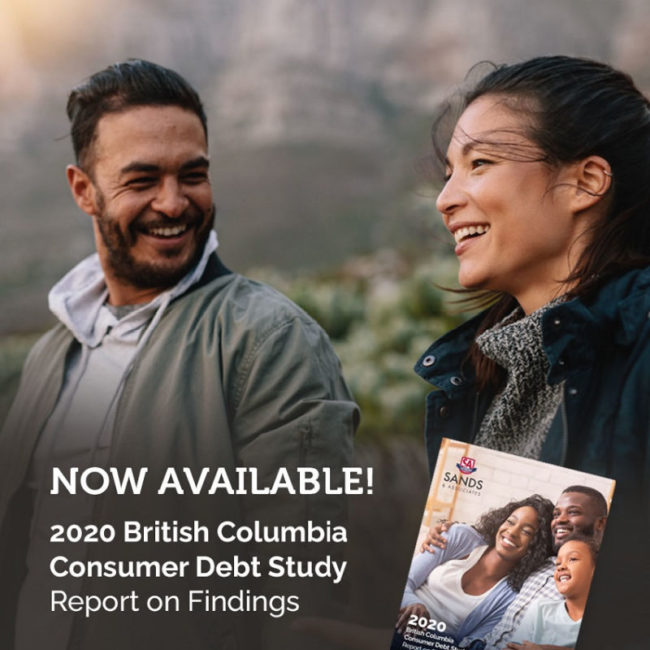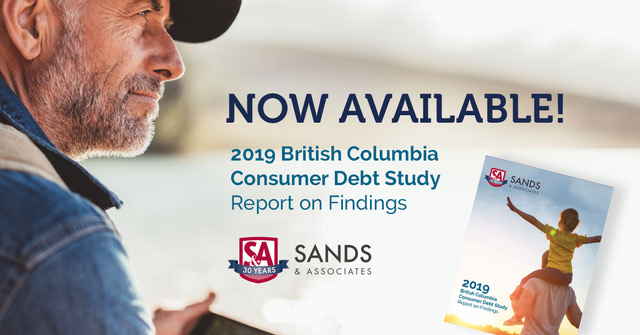Almost 4 in 5 people polled in the 2022 BC Consumer Debt Study said their mental health suffered being in debt.
Findings from the 2022 BC Consumer Debt Study were released today, offering a unique and frank view of consumer debt issues British Columbians face. Conducted by Sands & Associates, over 1,400 individuals from around the province who recently declared bankruptcy or restructured their debts using a Consumer Proposal consolidation plan participated in the study, sharing detailed personal insights into their first-hand experiences dealing with – and ultimately resolving – problem debt.
The tenth in the annual series and only study of its kind specifically focused on BC, according to Sands & Associates President and Licensed Insolvency Trustee Blair Mantin, the study series sheds much-needed light on the realities that money pressures present. As Blair explains:
“Inflation, housing, the global coronavirus pandemic – those are just a few recent widespread issues that can translate into debt for many consumers, on top of common financial pressure events such as a marital breakdown or illness. It’s not one specific group being impacted either, from those early in their careers to seniors well into retirement and everyone in between – debt often appears as a tool to lean on, then turns into a serious issue with a desperate borrow-repay-borrow cycle. Being in debt deeply affects people; we see you, we hear you.
A debt problem can escalate dramatically, and we know as debt help professionals it’s a problem that has well defined solutions. But for the individual struggling, overwhelmed, ashamed – they don’t have the benefit of these insights. And this is part of why this study series is so important. If you’re dealing with a debt problem you’re not alone, and, beyond any account balances, most of all you owe it to yourself to get help when you need it.”
Click here to read the full 2022 BC Consumer Debt Study report
Click here to view and download the 2022 BC Consumer Debt Study infographic
Consumer Debt Issues in BC – Highlights from the 2022 BC Consumer Debt Study
The 2022 BC Consumer Debt Study’s largest proportion of participants (34%) said they had $25,000-$49,999 of debt (excluding vehicle loans/mortgages) at the time they started a formal debt relief process.
- Roughly 30% of all study participants described their credit rating at this time as ranging from ‘good’ to ‘excellent’.
- Almost 3 in 5 individuals (59%) said credit card debt was the main type of debt they had – nearly 6 times higher than the next most common type of debt.
- Payday or instalment loans were reported as the main type of debt for 11% of respondents, making this the second-most common type of debt reported by survey participants for the first time in this study’s history.
- Tax debt and line of credit debt were each cited as the main type of debt for 9% of participants.
Although credit card debt continues to dominate as the most-reported type of debt, the recent increase in payday or instalment loan use is notable: payday or instalment loans were indicated as the main type of debt held by just 5% of 2019 BC Consumer Debt Study respondents, compared with 11% in this year’s study.
Behind the Debt
Uncovering the common causes of accumulated debt reveals much about the difficulties that participants in the 2022 BC Consumer Debt Study faced, particularly as we note that 4 of 5 most reported causes of debt relate to triggering events or circumstances that would generally fall outside an individual’s explicit control:
- 1 in 5 people (20%) polled said the direct main cause of their debt was using credit for essential costs of living income could not cover, while 1 in 4 (28%) said their debt was caused by overextended credit due to general financial mismanagement.
- Following these, causes of debt were attributed to: Illness, injury or health-related problems (10%); Marital or relationship breakdown (8%); Job-related issues (6%).
Although the 2022 BC Consumer Debt Study found the lowest proportion of survey participants who, following pre-pandemic trends, connect the main cause of their debt to job issues alone, a total of 6% of respondents did identify job or business disruptions due to COVID-19 as the direct main cause of their debt. The effects of the COVID-19 pandemic warrant continued observation, as the impacts are likely to continue to be felt by consumers and businesses for years to come.
The Cost of Debt – More Than Just Financial
The emotional toll of debt was the number one sign of a debt problem as reported by consumers in the 2022 BC Consumer Debt Study:
- Almost 7 in 10 people (69%) said overwhelming stress was how they knew their debts were becoming a problem.
- Other signs of debt trouble reported most by survey participants were: only making minimum payments, as reported by almost 6 in 10 people (58%); seeing debt balances remain almost the same every month, despite making payments (53%); accumulating more debt on credit accounts (36%).
Carrying burdensome debt came at a high cost, felt far beyond account balances by most individuals polled. Study participants detailed a range of effects from dealing with debt, including:
- Close to 4 in 5 people (79%) said their mental health suffered being in debt; 63% said their self-esteem suffered as a result, and 47% that debt affected their physical health.
- Over 4 in 5 (82%) said they felt constant worry about debt; 3 in 4 (76%) had anxiety from the stress of debt; 66% feelings of helplessness and/or hopelessness; 60% depression.
- Roughly 1 in 7 people said debt-stress resulted in them experiencing thoughts or contemplation of suicide.
Many people polled also reported effects from debt on their personal milestones and important relationships:
- 30% of survey participants said they had to put life events on hold.
- 30% said their relationships suffered and 29% said debt-stress caused them to alienate themselves from family or friends; 25% said it caused arguments with their spouse or partner about money.
Dealing With Debt
Notwithstanding the significant impacts of debt on survey respondents’ daily lives, reaching out for help was often made more difficult by emotional barriers and a damaging lack of information about options for resolving problem debt. The result is that only 5% of people suffering with a debt burden said they sought help right away from a debt professional.
In addition to wanting to manage my debt on my own (reported by 65% of study respondents) common reasons that caused participants to wait to seek professional debt help sadly included:
- Feeling ashamed I couldn’t handle the debts I had incurred (55%), embarrassed to ask for help (51%), and worried about being judged (40%).
- Over 1 in 4 people (28%) said they didn’t know where to seek help, and 15% had misinformation about how legal debt relief processes worked.
Many survey participants attempted to resolve their debt problems on their own before turning to legal resources, often looking to access more credit as a solution to deal with debt, including:
- A third of individuals polled (33%) tried applying to extend credit limits on existing debts.
- 29% borrowed from family or friends to make debt payments.
- 27% applied for consolidation financing; 6% asked family or friends to co-sign a consolidation loan.
- 23% used payday or instalment loans.
Improved Financial Outlook
The individuals surveyed in the 2022 BC Consumer Debt Study ultimately chose to manage their debts through a formal debt solution (Consumer Proposal consolidation or bankruptcy), and over 90% said they were satisfied, if not extremely satisfied by their choice.
Survey participants expressed notably positive sentiments about their decision and some of the key outcomes from their experience included:
- More than 7 in 10 people (73%) said their experience receiving professional debt help allowed them to improve their budgeting and/or savings skills, and 57% reported being more confident in day-to-day financial management as a result of their experience.
- 53% said they have a better understanding about credit and borrowing.
- 39% also say they are more open in discussing finances and general money matters with others.
Participants of the 2022 BC Consumer Debt Study were also invited to share their retrospective advice, and words of encouragement to others who may be struggling with debt – and we encourage readers to learn more through these deeply personal insights offered, as highlighted within the 2022 BC Consumer Debt Study report.
Click here to read the full 2022 BC Consumer Debt Study report
Click here to view and download the 2022 BC Consumer Debt Study infographic
View the BC Consumer Debt Study series here
For further details about BC Consumer Debt Studies or media inquiries contact Sands & Associates President Blair Mantin
About Sands & Associates and BC Consumer Debt Studies
Since founding in 1990 Sands & Associates has grown to become an award-winning industry leader, now BC’s largest firm of Licensed Insolvency Trustees focused exclusively on debt help services for consumers and small businesses across the province.
Sands & Associates is committed to delivering empowering and non-judgmental support to British Columbians, through our media and financial literacy initiatives and one-on-one consultations. We are proud to be described as having a “Debt Smart with Heart” approach and when it comes to getting debt help, we believe you owe it to yourself. Everyone is entitled to live with dignity, without the overwhelming stress of debt.
Our debt help services are available in person at local offices throughout BC, or remotely by video and telephone conferencing. Connect with a Sands & Associates BC debt help expert today – book your free non-judgmental debt consultation now.







